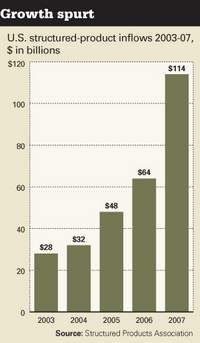By IAN SALISBURY
July 17, 2008
This might have been the year of the exchange-traded note, with fund firms and investment banks launching more than 60 new ETNs.
As it turns out, investors have so far turned up their noses at most of these complicated ETF-like securities. While the bulk of new products focus on red-hot assets like oil and other commodities, drawbacks such as credit risk, complicated strategies and uncertainty about the securities' tax status have kept many investors on the sidelines.
"I've talked with a lot of [financial advisors] and they've been staying away," says Ronald DeLegge, a former financial advisor who now offers ETF investing advice to online subscribers. "You've got a lot of risks with these things."
Exchange-traded notes have collected about $7.2 billion in assets since the first ones were launched in 2006, according to fund researcher Morningstar Inc. But the bulk of that, about $6 billion, is in 30 ETNs by Barclays PLC, which invented the product.
Another 59 ETNs created by eight other providers, mostly this year, hold just $1.29 billion, collectively, or about $22 million on average.
In all, 78 of the 89 ETNs on the market have less than $100 million. Barclays couldn't be reached for comment.
Investors, of course, could warm to new ETNs over time. It sometimes takes new funds several years to build a following. Still, ETNs' struggles seem to mirror those of their close cousins exchange-traded funds, where fund companies launched hundreds of products hoping to replicate success of a few early blockbusters and garnered only mixed results.
For the full article from the Wall Street Journal, click here.
Monday, July 21, 2008
Subscribe to:
Post Comments (Atom)




No comments:
Post a Comment